EU ETS: how would the different reports under discussion in the European Parliament affect the EU carbon market?
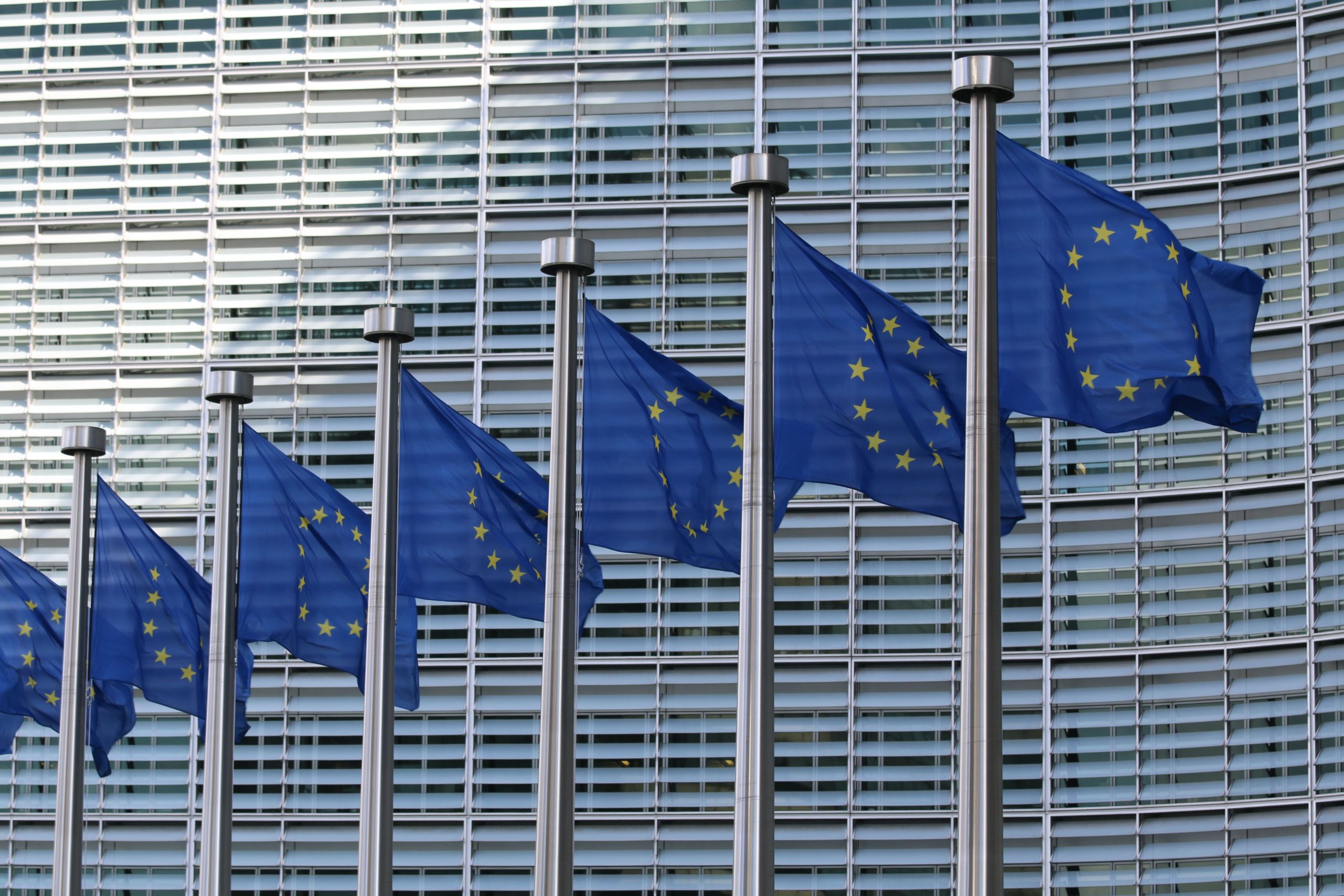
The EU is currently revising its EU Emission Trading System (EU ETS), which is one of the key tools to achieve the -55% reduction objective for 2030 and climate neutrality by 2050.
Climact has previously published a simulation tool which allows to assess the impact of a number of key proposals on the overall supply and demand, the evolution of the surplus and the expected auctioning and free allocation volumes. This model has now been updated to:
- Take into account different amendments to the Commission’s proposal (in particular, the amendments proposed by rapporteur Pieter Liese en those proposed by CBAM-rapporteur Mohamed Chahim);
- Provide detailed results on auctioning and free allocation volumes at the level of member states.
The updated model is publicly available below.
Context
In July 2021, the European Commission has started the revision of the EU ETS to align it with the -55% reduction objective for 2030. Earlier this year, Climact published a short report which assessed the impact of this proposal on a number of key parameters such as the overall supply-demand balance. The model which was used for the analysis was also made publicly available. Both the report and the model were published here.
Discussions are currently ongoing both within the Council as within the European Parliament on the proposed revision. Two key reports with amendments are currently debated within the Parliament which will affect the functioning of the carbon market:
In January 2022, Pieter Liese (EPP) – the rapporteur on the ETS revision – published a draft report with several amendments to the Commission’s proposal;
A few weeks earlier, Mohammed Chahim (S&D) – the rapporteur on a related legislative proposal on Carbon Border Adjustment Mechanisms – also published a draft report with amendments which will also affect certain aspects of the EU ETS.
These reports will be discussed and voted within their respective Parliamentary committees in the coming weeks, which will be a key milestone in the decision-making process.In order to continue supporting and feeding the debate, Climact has updated its previous ETS model, i.a. to take into account the different changes proposed by both rapporteur Liese as rapporteur Chahim.
Updated model
The updated model is available here
Key changes compared to the previous version of January 2022:
- The model now includes 4 predefined scenarios: the proposal of the European Commission, the Liese report, the Chahim report, and a fourth scenario with a more ambitious phase-out of free allocations. This last scenario was developed at the request of and based on input from Carbon Market Watch.
- The model now also produces outputs on the expected volumes of auctioning and free allocation at the level of the member states.
- Emission figures were updated based on the latest verified emissions (for 2021) as reported by 31 March 2022.
Key finding 1 – neither scenario would significantly alter the overall supply of allowances under the ETS, but there are significant changes in the structure of the supply
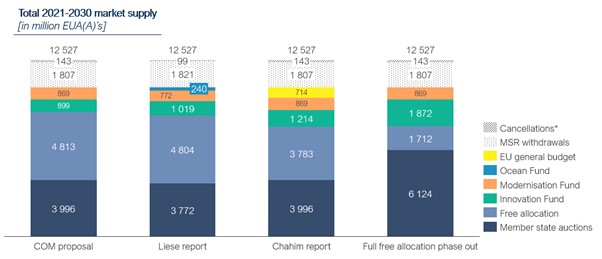
Under the Liese report, the main change is the introduction of an ‘Ocean Fund’, which would receive the revenues of 240 million allowances to support innovation in the maritime sector. This Ocean Fund would be financed at the expense of member states’ auctioning volumes. Furthermore, the Innovation Fund would increase with 120 million allowances compared to the Commission scenario, mainly at the expense of the Modernisation Fund;
Under the Chahim report, national auctioning volumes would remain unchanged compared to the Commission proposal. Free allocation volumes would decrease significantly (by -20% or a little over 1 billion allowances). Non-allocated allowances would be auctioned at the benefit of the EU budget (714 million allowances) and the Innovation Fund (+315 million allowances compared to the Commission proposal)
In case of a rapid and full phase-out of free allocations (the ‘full free allocation phase out’ scenario), freely allocated allowances would decrease by 65% (or 3.1 billion allowances) over the entire period 2021-2030. The non-allocated allowances have in this scenario been redistributed between national auctioning volumes (+- 2.1 billion allowances) and the Innovation Fund (+- 1 billion allowances)
Key finding 2 – the Liese report would signficantly decrease the auctioning volumes of most member states, with overall a stronger decrease for low-income member states
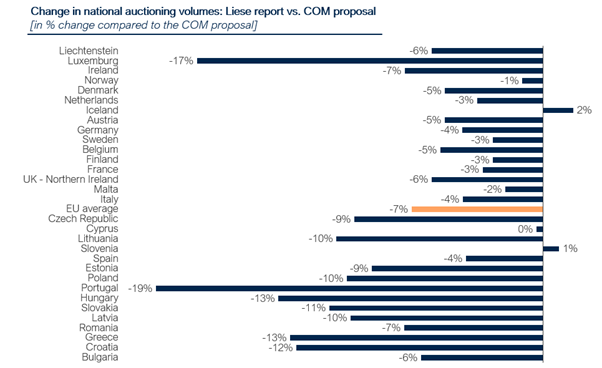
Overall, most member states would see a reduction in their auctioning volumes compared to the original Commission proposal. Underlying reason is the shift of auctioning volumes from member states to the Ocean Fund. On average, national auctioniong volumes would be reduced by 7% (for the entire period 2021-2030)
A second driver of change is the proposed redistribution of the Modernization Fund (which would be based on the distribution key for the Just Transition Fund). This second driver causes the decrease of auctioning volumes to somewhat softened for higher-income member states (which would now also receive part of the Modernization Fund) and amplified for lower-income member states.
Key finding 3: the Chahim report would reduce free allocations further by an estimated 1025 million allowances, compared to the Commission proposal
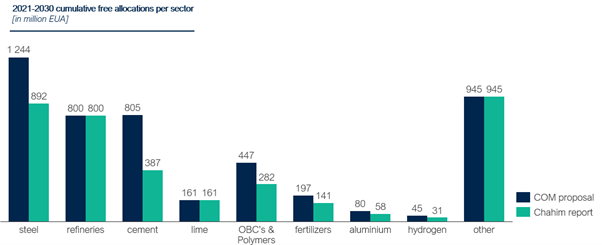
There are two underlying drivers of this further reduction:
- Rapporteur Chahim proposes a faster phase in of Carbon Border Adjustment measures, and therefore a faster phase-out of free allocations for covered sectors. This reduces total free allocations by 850 million allowances over the period 2021-2030;
- Furthermore, rapporteur Chahim proposes to expand the CBAM regulation to the hydrogen, organic basic chemicals and polymers sectors. This would reduce free allocation volumes with an additional 175 million allowances.
At a country level, the reduced amount of free allocation levels would mainly impact installations in Germany (-230 million), followed by France (-106 million), Spain (-88 million), Italy (-84 million) and Poland (-80 million).
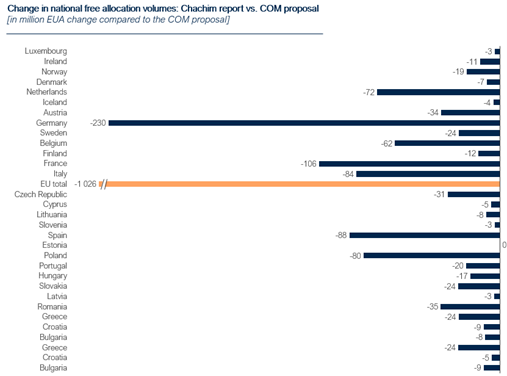
Share
Latest news & publications
-
Event
Our webinar: transition planning – the role of the board
-
Industry and services
We Supported Lineas in Their Climate Journey
-
Buildings
Accelerating the financing of residential renovations in Belgium
-
News
Introducing our latest tool: the European City Calculator!
-
News
We support BNP in their climate journey
-
News
Bridging the Climate Data Gap: A nuanced approach for Financial Institutions
-
News
Whitepaper: Getting your company ready for Net Zero
-
Industry and services
Navigating Scope 3 Emissions: A Pragmatic Approach with an Impact
-
Event
Replay : Getting your company ready for net zero (webinar 21/06/23)
-
Buildings
Pre-financing energy renovation, an energy-efficient home for every Flemish household
-
News
Reduction strategy: what goal should you aim for by 2030 and 2050?
-
News
How to measure greenhouse gas emissions and what scope to take into account
Get in touch with our experts
{{'NOUS_CONTACTER' | translate}}